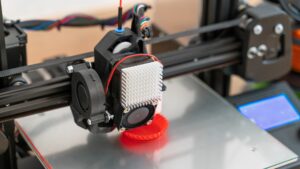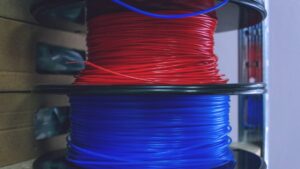
A Look at the Different Densities of 3D Printing Materials
There’s so much to learn about 3D printing materials. Come and find out what to look for when examining the different densities of 3D printing filaments.
844-810-1385
Rapid prototyping is a common method of 3D printing, but many people think the terms are interchangeable. What is rapid prototyping in 3D printing, and are the two processes identical? Read on to learn how to use rapid prototyping here in our brief guide.
Rapid prototyping is mass-producing one singular prototype at a time—a 3D printer CAD program is used along with the chosen filament to produce large prototype quantities. Rapid prototyping with or without a 3D printer can help define the difference between a high- and low-fidelity model.
While 3D printing and rapid prototyping go hand in hand, they’re two processes that mean different things. Despite using similar techniques, the most significant difference is the process. Rapid prototyping is the quicker prototype creation process, while 3D printing describes the additive manufacturing process.
Rapid prototyping uses many technologies; most methods rely on layering 3D printing and casting, molding, extruding, and high-speed machining.
Aside from the most common usage of rapid prototyping, you have two other techniques to use, subtractive and compressive.
The subtractive process cuts away from a material block to create a specific shape. Whether grinding, milling, or turning, the subtractive process removes material.
The compressive process forces a liquid or semi-solid material into a shape before it’s turned solid. This process uses molding, compressive sintering, and casting techniques to form a textile.
Now that you have a general idea of the differences between rapid prototyping and 3D printing, it’s good to know the distinctions between the diverse ways to use rapid prototyping. All you need to know is there are two types of rapid prototyping: low fidelity and high fidelity.
The low-fidelity models are test models. These models range from hand-drawn sketches on paper to digital blueprints. Concept designers find and understand issues the prototype may have in this stage before initializing the next prototype.
High-fidelity prototypes are the higher-quality examples. To achieve a high-fidelity prototype, creators add more detail to their models and shed the low-fidelity models’ imperfections that didn’t work in the test samples. This model isn’t a finished product , but it’s a close representation of your final model.
You have the freedom to pick any 3D printer filament you’d like in rapid prototyping. Depending on what you need, you may need to limit your selections. For example, you may want to avoid warping but have something that handles elevated temperatures, so using the copolyester filament might be the right choice.
Filamatrix is proud to offer its customers various fibers for their rapid prototyping needs. If you want to know more about the different filaments to use, browse our online store. There’s no limit to what you can use. We’re excited to see what prototype you make with 3D printing filaments.

There’s so much to learn about 3D printing materials. Come and find out what to look for when examining the different densities of 3D printing filaments.

Those interested in 3D printing have a lot to learn on how to use the system properly. Find out what you need to know about 3D printing and humidity levels.

3D printing has many variables that both beginners and experts need to know. Find out what effects temperature has on 3D printer filament.
Get professional insights, industry news, and our latest deals